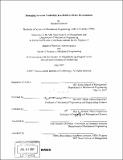Managing forecast variability in a build-to-order environment
Author(s)
Einhorn, Marshall
DownloadFull printable version (10.36Mb)
Other Contributors
Leaders for Manufacturing Program.
Advisor
David E. Hardt and Roy E. Welsch.
Terms of use
Metadata
Show full item recordAbstract
In any production environment, managing demand variability is a delicate balancing act. Firms must constantly weigh potential obsolescence costs of unused inventory (should sales not materialize) against potential expedite costs or lost sales (should demand outpace available inventory). For build-to-order manufacturers such as Dell, the balancing act is even more challenging. While it offers a wide array of products, Dell does not hold its safety stock in the form of finished goods inventory. Instead, safety stock is held as parts inventory, sitting in supplier-owned supplier logistics centers. As a result, supplier stocking decisions may impact Dell's ability to respond to forecast variability. Other factors, such as globalization, product proliferation, and geo-manufacturing, all magnify the impact variability has on the forecasting process. This thesis discusses two methods of dealing with demand variability. First, it examines the potential application of statistical modeling techniques to the part-level forecasting process. (cont.) In particular, it looks at the use of time series models to forecast part-level demand. While the results did not merit a recommendation to utilize time series forecasts across the board (in lieu of the current process), certain supplemental applications of such forecasts would benefit Dell. Second, it examines how hedging is currently utilized as a means to account for demand variability. While beneficial to Dell on the surface, a consistent hedge to the forecast is potentially detrimental to its vendor relationships. It has the direct impact of driving excess inventory onto the books of its vendors and it has the indirect impact of higher per part costs to Dell. It also exposes Dell to part shortages due to supplier decommits. To help counter these effects, the thesis identifies potential changes to the hedging process that Dell should consider.
Description
Thesis (M.B.A.)--Massachusetts Institute of Technology, Sloan School of Management; and, (S.M.)--Massachusetts Institute of Technology, Dept. of Mechanical Engineering; in conjunction with the Leaders for Manufacturing Program at MIT, 2007. Includes bibliographical references (p. 61).
Date issued
2007Department
Leaders for Manufacturing Program at MIT; Massachusetts Institute of Technology. Department of Mechanical Engineering; Sloan School of ManagementPublisher
Massachusetts Institute of Technology
Keywords
Sloan School of Management., Mechanical Engineering., Leaders for Manufacturing Program.